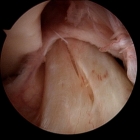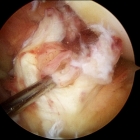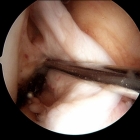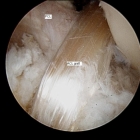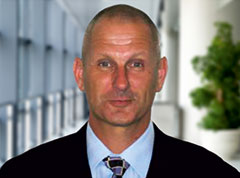The anterior cruciate ligament is a strong band of tissue that sits in the centre of the knee. It is very important in preventing rotation of the knee. The ACL is commonly injured during sport. This may occur with contact injuries or more commonly with non contact twisting injuries.
Tearing of the ACL often leaves the knee feeling unstable. A torn ACL will usually prevent most high level sporting activity and occasionally even low level activity will be difficult.
Symptoms
The ACL is usually torn in relatively high energy injuries, sometimes however, a seemingly innocuous twisting injury to the knee can cause a tear to the ACL.
Initially it is usually painful when the ACL tears and many patients are unable to bear weight through the knee. With time the pain often settles. The most common symptom then is instability. This is a feeling of the knee “giving way”.
If the knee only gives way with sporting type activity then some patients may wish to avoid sport and rehabilitate their knee through physiotherapy. Those patients unwilling to cease sport will require ACL reconstruction to avoid instability and enable them to participate in sport. For those patients with instability during normal activity, ACL reconstruction will be required as ongoing or recurrent instability is associated with further injury within the knee.
The Surgery
Anterior cruciate ligament reconstruction involves recreating the torn anterior cruciate ligament. Usually a new ligament can be reconstructed from other body tissue (a tendon graft). The most common tissue to use is the medial hamstring tendons.
Occasionally other tissue such as the patella tendon can be used. Rarer still an artificial ligament (LARS) may be used.
ACL reconstruction surgery is mostly performed as an arthroscopic procedure. This means that most of the surgery can be done via small (keyhole) incisions. There will however be an incision from the site where the tendon graft is harvested.
The surgery essentially involves harvesting the tendon graft and preparing it for implantation. Holes are then drilled in the bones of the knee (femur and tibia). The graft is then placed via the bone holes into the correct position within the knee and fixed in place.
Rehabilitation
Most patients who have an ACL reconstruction will stay overnight in hospital. Presuming that there are no other injuries that require different rehabilitation (meniscal repairs other knee ligament repairs) weight can be taken through the operated leg the next day. Usually crutches will be required for a short period of time. There will be some gentle exercises to perform in the first 2 weeks whilst the surgical incisions heal.
After this a physiotherapy program is essential.
Limitations
Initially the reconstructed ACL is very weak compared to a normal ACL. As such, it needs to be protected. Physiotherapy and increasing muscle bulk is helpful but the most important factor is avoiding injury to the knee especially a twisting injury. Even relatively trivial events can rupture the new ACL in the first months.
Most patients can avoid injury and perform their normal daily living activities and work. Patients, whose work, places high demands on their knee, may need time off work and are at increased risk for injury when they return.
Most elite athletes return to sport around 6 months post ACL reconstruction surgery. These athletes however, have usually had physiotherapy and exercise to increase muscle bulk every day and are paid to take risks. The average person who wishes to return to sport is usually not ready until 1 year has passed from the time of surgery.
Patients who have other injuries repaired at the same time especially meniscal cartilage repairs and other knee ligament repairs will require a different rehabilitation course.

